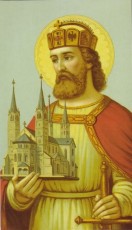Catholic Saints

Saint Stephen of Hungary
Feast Day: August 16
Patronage: Kings, Rulers
St. Stephen of Hungary was born as Vajk, in the town of Esztergom. His father was the Grand Prince of Geza of Hungary. His mother was also born of nobility and was from Greece, as that is where she was baptized. According to legend, St. Adalbert of Prague baptized Vajk a Christian. He was given the baptismal name of Stephen in honor of the original early Christian St. Stephen. The baptized name was possibly chosen on purpose, as it means not only “crown” but also “standard or norm” in Hebrew. The mission of St. Stephen was to grant a norm to Hungary through the Holy Crown.
When Stephen reached his teenage years, it was decided that Stephen would follow his father as the monarch of the Hungarians. Stephen married and became the brother-in-law of the future Henry II, Holy Roman emperor. In 1997 his father died, and Stephen claimed to rule by the principal of Christian Divine Right, while his uncle claimed traditional right. After they met in battle, Stephen was victorious.
According to Hungarian tradition, Pope Silvester II, sent a magnificent jeweled gold crown to Stephen along with an apostolic cross and a letter of blessing officially recognizing Stephen as the Christian King of Hungary. St. Stephen is closely tied to the Crown of Stephen and the Doctrine of the Holy Crown, which marks a unique tradition of the Kingdom of Hungary. According to legend, during his coronation Stephen dedicated the crown to the Holy Virgin, thereby sealing a contract between God and the crown, which is there considered a “Holy Crown”.
Stephen intended to retire to a life of holy contemplation and hand the kingdom over to his son Emeric, but Emeric was wounded in a hunting accident and died in 1031. Stephen’s words of mourning, “By God’s secret decision death took him, so that wickedness would not change his soul and false imaginations would not deceive his mind”. Stephen mourned for a very long time over the loss of his son, which took a toll on his health. Having no children left he could not find anyone among his remaining relatives who was able to rule the country competently and willingly to maintain the Christian faith of the nation. Without a living heir, on his deathbed, St. Stephen raised with his right hand the Holy Crown of Hungary, and prayed to the Blessed Virgin Mary, asking her to take the Hungarian people as her subjects and become their queen. He died on the feast day of the Assumption of Mary, August 15th, 1038.
Practical Take Away
St. Stephen shows us with his life that we can take Christ and our Christian principals into our work. St. Stephen wanted a life of holy contemplation, but became the King of Hungary. Even so, he ruled with the Christian principals of the church, winning for him a crown of jewels from the Holy Father of his time. This would become known as the “Holy Crown”, and it was through ruling with his Christian principals and the intercession of the Blessed Virgin Mary, that defined him as a great King, and even more, a great Saint. In following St. Stephen’s great example, are we doing all we can to take our Christian Principals into our work place? Don’t forget to call upon St. Stephen to assist us with this great task.





